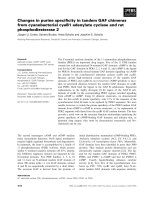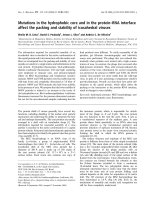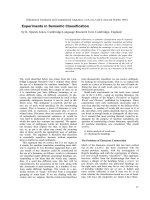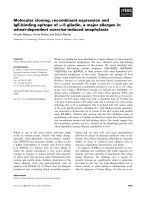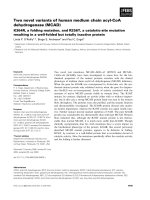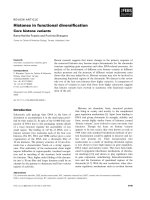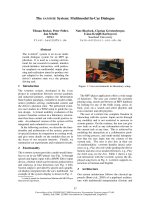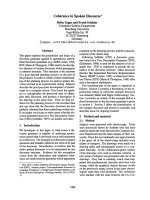Báo cáo khoa học: "Relapse in resected lung cancer revisited: does intensified follow up really matter? A prospective study" potx
Bạn đang xem bản rút gọn của tài liệu. Xem và tải ngay bản đầy đủ của tài liệu tại đây (534.8 KB, 11 trang )
BioMed Central
Page 1 of 11
(page number not for citation purposes)
World Journal of Surgical Oncology
Open Access
Research
Relapse in resected lung cancer revisited: does intensified follow up
really matter? A prospective study
Dragan Subotic*
1
, Dragan Mandaric
1
, Gordana Radosavljevic
1
,
Jelena Stojsic
1
, Milan Gajic
2
and Maja Ercegovac
1
Address:
1
Institute for Lung Diseases, Clinical Center of Serbia, Belgrade, Serbia and
2
Institute for Medical Statistics, Faculty of Medicine, Belgrade,
Serbia
Email: Dragan Subotic* - ; Dragan Mandaric - ; Gordana Radosavljevic - ;
Jelena Stojsic - ; Milan Gajic - ; Maja Ercegovac -
* Corresponding author
Abstract
Background: beside the well known predominance of distant vs. loco-regional relapse, several
aspects of the relapse pattern still have not been fully elucidated.
Methods: prospective, controlled study on 88 patients operated for non-small cell lung cancer
(NSCLC) in a 15 months period. Stage IIIA existed in 35(39.8%) patients, whilst stages IB, IIA and
IIB existed in 10.2%, 4.5% and 45.5% patients respectively. Inclusion criteria: stage I-IIIA, complete
resection, systematic lymphadenectomy with at least 6 lymph node groups examined, no
neoadjuvant therapy, exact data of all aspects of relapse, exact data about the outcome of the
treatment.
Results: postoperative lung cancer relapse occurred in 50(56.8%) patients. Locoregional, distant
and both types of relapse occurred in 26%, 70% and 4% patients respectively. Postoperative cancer
relapse occurred in 27/35(77.1%) pts. in the stage IIIA and in 21/40(52.55) pts in the stage IIB. In
none of four pts. in the stage IIA cancer relapse occurred, unlike 22.22% pts. with relapse in the
stage IB. The mean disease free interval in the analysed group was 34.38 ± 3.26 months.
The mean local relapse free and distant relapse free intervals were 55 ± 3.32 and 41.62 ± 3.47
months respectively Among 30 pts. with the relapse onset inside the first 12 month after the lung
resection, in 20(66.6%) pts. either T3 tumours or N2 lesions existed. In patients with N0, N1 and
N2 lesions, cancer relapse occurred in 30%, 55.6% and 70.8% patients respectively
Radiographic aspect T stage, N stage and extent of resection were found as significant in terms of
survival. Related to the relapse occurrence, although radiographic aspect and extent of resection
followed the same trend as in the survival analysis, only T stage and N stage were found as
significant in the same sense as for survival. On multivariate, only T and N stage were found as
significant in terms of survival.
Specific oncological treatment of relapse was possible in 27/50(54%) patients.
Conclusion: the intensified follow up did not increase either the proportion of patients detected
with asymptomatic relapse or the number of patients with specific oncological treatment of relapse.
Published: 12 November 2009
World Journal of Surgical Oncology 2009, 7:87 doi:10.1186/1477-7819-7-87
Received: 19 July 2009
Accepted: 12 November 2009
This article is available from: />© 2009 Subotic et al; licensee BioMed Central Ltd.
This is an Open Access article distributed under the terms of the Creative Commons Attribution License ( />),
which permits unrestricted use, distribution, and reproduction in any medium, provided the original work is properly cited.
World Journal of Surgical Oncology 2009, 7:87 />Page 2 of 11
(page number not for citation purposes)
Background
Despite the well known predominance of distant vs. loco-
regional relapse in patients operated for primary NSCLC,
several aspects of the relapse pattern still have not been
fully elucidated. Data about lung cancer relapse are usu-
ally added to long term survival data, mainly without
details other than about the form of relapse [1,2]. There
are few reports specifically addressing the pattern of
relapse including exact onset of relapse, the way of detect-
ing relapse (symptom based/controls) and treatment, tak-
ing account of tumour and patient related characteristics
[3].
We set out to determine if intensified follow up of these
patients could influence the outcome of treatment
through earlier detection of relapse and initiation of treat-
ment. Our hypothesis was that the reason for treatment
failure in many operated patients, independently of the
way of preoperative mediastinal assessment, could be the
existence of clinically occult micrometastases at the time
of operation, leading to early, unrecognized cancer
relapse, usually with delayed, if with any specific treat-
ment.
The aim of the study was to assess whether the intensified
follow up of the operated patients contributes to the ear-
lier treatment of relapse or indicates the way of improving
the preoperative patient selection.
Patients and methods
Prospective, controlled study that included 88 patients
with complete lung resection for NSCLC in the period
December 2002 - March 2004.
The mean age of patients was 55 years, ranging 42-77
years, M:F 6.3:1.
Stage IIIA existed in 35(39.8%) patients, whilst stages IB,
IIA and IIB existed in 10.2%, 4.5% and 45.5% patients
respectively.
In the present study, the 1997 revision of TNM system was
used in order to determine the disease stage based on the
operative specimens of the lung tissue and harvested
lymph nodes.
Inclusion criteria
Stage I-IIIA; complete resection; systematic lymphadenec-
tomy with at least 6 different lymph node groups exam-
ined; no neoadjuvant therapy; exact data about tumour
histology, tumour diameter, grade of tumour differentia-
tion, visceral pleural involvement, vascular and lymphatic
invasion; regular monthly contacts with patients and writ-
ten report about the patient's status; exact date of the
relapse suspicion and confirmation; exact data about the
site of relapse; evidence of pathologic confirmation of
relapse; precise evidence about treatment of the relapse -
date the treatment began and ended, form of the treat-
ment; outcome of the treatment (alive and disease free,
alive with disease, dead); date of death; cause of death.
Preoperative work up
Standard clinical and laboratory investigations, bronchos-
copy, high-resolution CT of the thorax and upper abdo-
men, respiratory function tests, blood gasses in the arterial
blood.
Mediastinoscopy was not routinely performed in the ana-
lysed period.
In patients with moderate to severe COPD), combined
bronchodilator therapy, with or without antibiotics was
applied. Patients with FEV
1
and 100 FEV
1
/VC greater than
60% at control spirometry. were referred directly to sur-
gery. Patients with FEV
1
and 100 FEV
1
/VC lower than 60%
at control spirometry, were subjected to perfusion scintig-
raphy of the lungs, in order to calculate the predicted post-
operative FEV
1
(ppoFEV
1
). They were referred to surgery if
their ppoFEV
1
was greater than 30% predicted.
Follow up and data analysis
Follow up period: December 2002-December 2008.
In the analyzed group, an intensified follow+up was
applied. The term "intensified follow up" relates to regu-
lar monthly phone contacts with patients and/or their
families in order to get reliable information about the
patient's general condition and eventual new complaints
that were not present on discharge. Independently of this
follow up, all the included patents were regularly control-
led in the outpatient clinic at one month intervals during
the first 3 months, than at 3 months intervals till the end
of the first postoperative year. During the second and
third postoperative year, intensified follow up was com-
bined with regular outpatient controls at 4 months. Fur-
ther outpatient controls were shaduled at 6 months
intervals, combined with intensified follow up as
described.
Data were collected from the original patients' hospital
and outpatient dossiers and by contacting the patients or
their relatives or physicians by phone. The obtained
demographic and clinical data, including age, gender, pul-
monary function, comorbidity, quality of life after the
operation, as well as perioperative data, consisting of sur-
gical procedure, pathologic stage, and operative morbid-
ity and mortality, were entered into the database.
The overall and disease free survival were calculated, as
well as local relapse free and distant metastases free sur-
World Journal of Surgical Oncology 2009, 7:87 />Page 3 of 11
(page number not for citation purposes)
vival. Disease free survival corresponds to the length of
time after the operation during which a patient survives
with no signs of disease.
Locoregional relapse-free interval represents the time
interval (in months) between the operation and diagnosis
of the locoregional relapse. As for this type of relapse,
symptoms may not be reliable in terms of the existence of
relapse. the moment of the relapse diagnosis by imaging
and/or biopsy represented the moment of the relapse
onset.
Distamt relapse-free survival refers to the time interval (in
months) between the operation and detection of distant
metastases. In patients with subsequently confirmed
brain or bome metastases, the appearance of first specific
symptoms was accepted as the time of the relapse onset.
Cancer relapse inside the first 12 postoperative months
was particularly analysed.
Univariate and multivariate analysis of factors influencing
the overall survival and the relapse occurrence included:
interval between the onset of symptoms and operation,
radiographic aspect, bronchoscopic aspect, tumour diam-
eter, T and N stage, visceral pleural involvement, extent of
resection and adjuvant treatment.
Statistics
T-test for independent samples was used to assess the
influence of the Tu diameter to the length of the interval
operation-relapse and to the pattern of relapse occurrence
(inside the first postoperative year or later).
Chi-square test.was used to assess the influence of the per-
centage of N2 lesions to the length of the interval opera-
tion-relapse and to the occurrence of relapse inside the
first postoperative year. year. Also this test was used to
assess the distribution of N2 lesions depending of the type
of T2 descriptor. Survival was estimated by the Kaplan
Meier method.
Multivariate analysis of prognostic factors was performed
via Cox proportional hazard regression with backward
elimination until all remaining model parameters were
significant at the 0.05 level.
Results
Structure of the analysed group
The mean age of patients was 55 years, ranging 42-77
years, M:F 6.3:1.
Stage IIIA existed in 35(39.8%) patients, whilst stages IB,
IIA and IIB existed in 9(10.2%), 4(4.5%) and 40(45.5%)
patients respectively.
There were 38 right sided and 50 left sided tumours.
Thirty five patients underwent lobectomy and 53 under-
went pneumonectomy.
In 67 (76%) patients squamous cell carcinoma existed.
There were 18 patients with adenocarcinoma, one with
bronchioloalveolar carcinoma and two with adenosqua-
mous carcinoma. Postoperatively, 23(26.1%) patients
underwent adjuvant therapy (21 irradiation and 2 chem-
otherapy).
T stage; N stage
Of 70 patients with T2 tumors, tumour diameter (>3 cm)
was the only T descriptor in 41(58.6%) patients, visceral
pleural involvement was the only T descriptor in 2
patients, whilst in the remaining 27(38.6%) patients,
both tumour diameter >3 cm and visceral pleural involve-
ment existed (table 1). Five different T3 descriptors were
almost equally distributed.
Mediastinal lymph node metastases existed in 12(29.35)
patients with tumour diameter as the only T2 descriptor
and in 9(33.3%) patients with visceral pleural involve-
ment (P > 0.8136).
Although the survival of patients with T2 tumours and vis-
ceral pleural involvement was inferior vs. patients with
intact visceral pleura, this survival difference was not sta-
Table 1: T-descriptors
T2 tumours
n%
Rtu > 3 cm 41 58.6
visceral pleura 2 2.8
Rtu> 3 cm + visceral pl. 27 38.6
total 70 100
T3 tumours n%
chest wall 4 28.6
parietal pleura 3 21.5
mediastinal pleura 2 14.2
pericardium 3 21.5
< 2 cm from carina 2 14.2
total 14 100
World Journal of Surgical Oncology 2009, 7:87 />Page 4 of 11
(page number not for citation purposes)
tistically significant-median survival 34 ± 7 months vs. 26
± 7 months (figure 1).
The percent of positivity of the examined mediastinal
lymph nodes varied between 2.8% for pulmonary liga-
ment nodes and 17.8% for the upper paratracheal nodes.
Metastases in hilar, interlobar and lobar lymph nodes
were confirmed in 29.5, 22.4 and 81.8% of examined
lymph nodes.
Pattern of relapse; disease free survival
The type of relapse according to stage is presented on table
2. During the follow up period, postoperative lung cancer
relapse occurred in 50(56.8%) patients. In 44 patients
symptoms existed, whilst in 6 asymptomatic patients
relapse was detected at regular controls.
Locoregional, distant and both types of relapse occurred
in 26%, 70% and 4% patients respectively. Postoperative
cancer relapse occurred in 27/35(77.1%) pts. in the stage
IIIA and in 21/40(52.5) pts in the stage IIB. In none of
four pts. in the stage IIA cancer relapse occurred, unlike
22.2% pts. with relapse in the stage IB.
In patients with N0, N1 and N2 lesions, cancer relapse
occurred in 30, 55.6 and 70.8% patients respectively.
Cancer relapse occurred in 37/67(55.2%) patients with
sqiamous cell carcinoma and in 13/21(62%) patients
with other cell types.
In patients with relapse, well differentiated, moderately
and poorly differentiated tumours existed in 10(20%),
Survival depending n visceral pleural involvement (gray line: visceral pleura intact, black line: visceral pleura invaded)Figure 1
Survival depending n visceral pleural involvement (gray line: visceral pleura intact, black line: visceral pleura
invaded).
World Journal of Surgical Oncology 2009, 7:87 />Page 5 of 11
(page number not for citation purposes)
25(50%) and 15(30%) patients respectively. In patients
without relapse, the same categories of the grade of
tumour differentiation existed in 6(15.9%), 24(63.1%)
and 8(21%) patients respectively.
The overall two, three and 5 year survival was 48.8, 40.2
and 33% respectively.
The disease free survival is presented on the figure 2. One
year after the operation, 62.7% patients were alive and
disease free. Two years after the operation 47.3% patients
were disease free, whilst the percentage of patients with-
out relapse decreased to 41.5 and 37.7% three and four
years after the operation.
The overall disease free interval, local relapse-free and dis-
tant relapse-free intervals are presented on the table 3. The
mean disease-free interval in the analysed group was 34.4
± 3.2 months (median 19, 95%CI: 6.62-31.38). The mean
local relapse-free and distant relapse-free intervals were 55
± 3.3 and 41.6 ± 3.5 months respectively.
One year after the operation, 90.4% patients were without
locoregional relapse. Two years after the operation 78.3%
patients were locoregional relapse free, whilst this per-
centage decreased to 70.7% four years after the operation
(figure 3a). The percentage of distant relapse free patients
decreased from 69.4 ± 5% one year after the operation, to
50.5 ± 6.2% four years after the operation (figure 3b).
Relapse inside the first postoperative year
Among 30 pts. with the relapse onset inside the first 12
month after the lung resection, the disease free interval <3
months, 3-6 months and >6 months occurred in
10(33.3%), 12(40%) and 8(26.7%) pts. respectively. In
20(66.6%) pts. in this group, either T3 tumours or N2
lesions existed (table 4). Although the tumour diameter in
patients with relapse inside the first postoperative year
was 79 ± 32 mm vs. 63 ± 19.8 mm in patients with later
relapse occurrence, this difference was not statistically sig-
nificant. Mediastinal lymph node metastases existed in
40.6% patients with relapse inside the first year vs. 22.2%
patients with N2 lesions and relapse after the first year (P:
0.395).
Distant metastases
Among 37 patients with metastases, one single and more
than one distant sites existed in 70.27% and in 29.73%
patients respectively. The most frequent distant site was
brain (51.4% pts), followed by bone (18.9% pts.), liver
and contralateral lung (16.2% pts. each). Metastases in
distant lymph nodes, adrenals and other sites were regis-
tered in five, three and two patients respectively.
Although the median disease free interval of 3 months
(95% CI: 0.39-5.61) in patients with brain metastases was
shorter than the same interval of 6 months in patients
with metastases in other sites, this difference is not statis-
tically significant (P: 0.0735).
Extent of resection; relapse treatment
The median disease free interval after lobectomy was 36
months vs. 16 onths after pneumonectomy (P: 0.0925).
Survival after lobectomy was significantly longer than
after pneumonectomy (figure 4).
Specific oncological treatment of relapse was possible in
27/50(54%) patients. Fourteen patients underwent radia-
tion therapy only; in 9 patients operative treatment was
performed, either as the only treatment modality (two
patients) or in combination (5 OP+RT, 2 OP+CT+RT).
Chemotherapy alone was given to two patients, whilst
one patient underwent chemotherapy combined with
radiation therapy.
Univariate and multivariate analysis of prognostic factors
Univariate analysis of factors influencing survival and
relapse occurrence are presented on the table 5. Radio-
graphic aspect (tumour shadows vs. other categories), T
stage (<T3 vs T3), N stage (N0/N1vs. N2) and extent of
resection (lobectomy vs. pneumonectomy) were found as
significant in terms of survival. Symptom duration longer
than three months (vs. < 3 months) and tumour diameter
<5 cm (vs. >5 cm) were associated with better survival, but
without statistical significance.
Table 2: Type of postoperative cancer relapse
LC relapse n%
with symptoms 44/50 88
without symptoms 6/50 12
locoregional 13/50 26
distant 35/50 70
locoreg.+ distant 2/50 4
relapse in IB 2/9 22.2
relapse in IIB 21/40 52.5
relapse in IIIA 27/35 77.1
relapse in pN0 3/10 30
relapse in pN1 30/54 55.6
relapse in pN2 17/24 70.8
World Journal of Surgical Oncology 2009, 7:87 />Page 6 of 11
(page number not for citation purposes)
Disease-free survivalFigure 2
Disease-free survival.
Table 3: Disease-free intervals
disease free interval (months)
mean SE 95% CI median SE 95% CI
overall 34.4 3.2 28.0-40.77 19.0 6.31 6.62-31.38
locrelapse-free 55 3.3 48.49-61.52 * * *
dist. relapse-free 41.6 3.5 34.83-48.42 * * *
*: median not presented (> 50% alive after 70 months postoperatively)
SE: standard error; CI: confidence interval
loc.relapse-free: interval without locoregional relapse
dist. relapse-free: interval without distant relapse
World Journal of Surgical Oncology 2009, 7:87 />Page 7 of 11
(page number not for citation purposes)
Related to the relapse occurrence, although radiographic
aspect and extent of resection followed the same trend as
in the survival analysis, only T stage and N stage were
found as significant in the same sense as for survival.
On multivariate, only T and N stage were found as signif-
icant in terms of survival.
Discussion
The main point of the present study is reliability of data
owing to regular short interval contacts with patients. So,
the obtained relapse pattern can be considered highly reli-
able and pure, i.e. uninfluenced by nonsurgical treatment
owing to the absence of patients with neoadjuvant treat-
ment. This could justify such a study design and expected
practical benefit. Moreover, although several factors have
been shown to affect survival, few studies have demon-
strated any correlation between these factors and tumor
recurrence. In fact, most studies focused on survival as end
point [4-6].
The type of lymphadenectomy in the present study was
complete removal of all palpable and visible lymph
nodes. Most of our patients had seven or more groups of
lymph node stations harvested. It was clearly demon-
strated that, after less than 4, 4-6, 7-9 nodes harvested, the
corresponding 5-year disease-free survival rates were
43.4%, 67.3% and 76.3% respectively [7]. It was also
recently shown that sampling adequately recognized N2
disease and multilevel N2 lesions in only 52% and 40%
patients respectively [8]. A certain recently expressed con-
cerns related to the influence of tumor side (the aforemen-
tioned advantages of dissection could not always be
confirmed in presence of left sided tumors) [9], did not
influence our current policy of lymphadenectomy.
The reason for particularly analyzing T2 descriptors lies in
the results of some recent studies which found visceral
pleural involvement as significant prognostic factor [10].
Despite the nearly equal percent of mediastinal lymph
node metastases in our patients with and without visceral
pleural involvement, a clear trend of survival worsening
Locoregional (a) and distant (b) relapse-free survivalFigure 3
Locoregional (a) and distant (b) relapse-free survival.
Table 4: Relapse during the first postoperative year
disease-free interval
(months)
< 3 3-6 >6
n%n%n%
10 33.3 12 40 8 26.7
interval operation-relapse
< 1 year > 1 year
Tu diameter (mm) 79 ± 32 63 ± 19.8
N2 (%) 40.6 22.2
P value Rtu: > 0.065; N2: 0.39
World Journal of Surgical Oncology 2009, 7:87 />Page 8 of 11
(page number not for citation purposes)
was found if the visceral pleura was invaded. However,
due to the absence of statistical significance (median sur-
vival 34 ± 7 vs. 26 ± 7 months), our results are in line with
studies demonstrating that, even in the stage I, the prog-
nostic significance of non-size based T2 descriptors
depends on tumor size. By the other hand, it was clearly
shown that, by not taking account of different T2 descrip-
tors, as many as 21.1% of the stage IB patients may be
unnecessarily upstaged from stage IA to stage IB as their
survival was not different from that of stage IA patients
[11].
The causes of a quite high relapse rate (56.8%) in the
present study during the follow up period can be dis-
cussed from several aspects. First, the predominance of
distant vs. locoregional type is an expected finding, usu-
ally explained by the variability in the pattern of lym-
phatic drainage and an incidence of skip metastases of 31-
74% [12]. Moreover, microscopic metastases in the N1
and N2 nodes are often below the limits of detection by
PET [13,14]. Second, in the majority of our patients with
relapse (30/50), relapse occurred inside the first 12
months after the operation, in 22/30 less than 6 months
after the operation. Such a finding clearly indicates the
existence of distant metastases in these patients at the time
of the operation, thus supporting the evidence of distant
metastases at the moment of operation as one of major
causes of understaging, even in the stage I [15]. Third,
greater tumour diameter in our patients with relapse dur-
ing the first 12 months vs. patients with later relapse (79
± 32 vs.63 ± 19.8 mm) underlines the role of the tumour
diameter, thus supporting observations that there is a
three-fold increase in the risk of having pathologic stage II
or stage III disease with every 1.0 cm increase in tumor
Survival depending on the extent of resection (gray line: lobectomy, black line: pneumonectomy)Figure 4
Survival depending on the extent of resection (gray line: lobectomy, black line: pneumonectomy).
World Journal of Surgical Oncology 2009, 7:87 />Page 9 of 11
(page number not for citation purposes)
size [16]. But, it is also true that the diameter after which
the risk begins to increase has not still been defined. The
association of the greater tumour diameter with higher
percentage of N2 lesions compared with smaller tumours
(40.6 vs. 22.2%) in our study, represents the reflexion of
already described doubling of risk for occult N2 lesions
with the increase of the tumour size from <1 cm to over 2
cm [17].
Despite the evidently higher proportion of local relapse-
free vs. distant relapse-free patients after the first (90.4 vs.
69.4%) and second postoperative year (78.3 vs. 50.5%),
the mean local relapse free and distant relapse free inter-
vals were not significantly different. Nevertheless, this evi-
dent difference during the first postoperative year clearly
reflects the relatively high percent of patients with early
relapse. As most of them had asymptomatic brain and
bone metastases, with around a third with more than one
metastatic sites, the way of extrathoracic assessment of the
disease can be put into question. It is clear that it should
be intensified, but based on the obtained results, (mostly
because of limited patient number), it is not possible to
conclude with certainty in which subset of patients it
should be done. It is now well known that the proportion
of patients with unexpected extrathoracic metastases var-
ies between 5-29% and that, even PET scan, (although
better than CT and bone scintigraphy in detecting liver
and bone metastases) is not a good technique in the
search for brain metastases [18,19]. Moreover, it was also
shown that even the combination of CT, bone scintigra-
phy, abdominal ultrasonography and PET scan still misses
micrometastases in about 20% of patients [20].
In brief, our expectation that this intensified follow up
will help to discover relapse in more asymptomatic
patients than without it was not confirmed, because in
88% of patients the relapse was discovered because of
symptoms and only in 12% at controls. Furthermore, a
specific oncological treatment (that could be the end
point of this intensified follow up) was performed in only
a half of the operated patients. Similarly, the overall sur-
vival of patients with relapse discovered by this form of
follow up was not different from usually reported rates in
the literature. It means that, in this subset of patients, sur-
vival is not subject to the influence neither of lead time
bias, nor of length time bias, that could cause the false
impression of prolonged survival associated with more
frequent patients' controls, that sometimes occurs in
some screening protocols.
When discussing unexpected relapse in our patients, it
should be mentioned that micro metastases to small
nodes without mediastinal nodes enlargement is reported
to occur in 8-60% pts. with mediastinal metastases
Table 5: Univariate and multivariate analysis of factors influencing survival and relapse
UNIVARIATE MULTIVARIATE
survival (months) relapse free interval (months) survival
median 95% CI P median 95% CI P SE df sig.
Rtg aspect Tumour
other categories)
44
16
26.12-61.88
8.59-23.41
0.0289 42
15
32.16-51.84
7.15-22.85
0.0557 0.361 1 0.743
T component < T3
T3
34
9.0
18.77-49.23
3.50-14.50
0.0007 34
8
17.87-50.13
5.92-10.08
0.0064 0.388 1 0.002
N component <N2
N2
34
8.0
13.70-54.29
5.61-10.39
0.001 34
6.0
14.17-53.82
0.0-13.98
0.002 0.291 1 0.019
Extent of resection lobectomy
pneumonectomy
.*
17
.*
9.87-24.13
0.0925 36
16
23.57-48.13
7.89-24.11
0.0925 0.477 1 0.298
Duration of symptoms
(months)
< 3
> 3
18
32
10.67-25.33
30.62-53.46
0.0623 17
37
6.83-27.17
21.28-52.42
0.1645 0.344 1 0.180
Bronchoscopic aspect normal
pathologic
26
22
0.00-54.51
12.42-31.58
0.7294 29
19
1.91-56.09
8.88-29.12
0.6950 0.308 1 0.579
Visceral pleura invaded
intact
24
22
9.74-38.26
5.88-38.12
0.5788 36
19
25.42-46.58
8.89-29.11
0.5094 0.362 1 0.598
*: median not presented (> 50% alive after 70 months postoperatively)
World Journal of Surgical Oncology 2009, 7:87 />Page 10 of 11
(page number not for citation purposes)
[21,22]. In the analysed group, relapse occurred in
patients with N0 and N1 lesions in 30 and 55.6% patients
respectively. Such a finding supports the significance of
analysis of extranodal extension, because it was demon-
strated that the 5-year survival rate of stage IIIA patients
without extranodal extension could be significantly better
than that of stage II patients with extranodal extension -
30.4 vs. 16.8% in some series [23]. Beside extranodal
extension, a possible cause of at least a part of relapse in
presence of N1 can be due to metastase in nonprimary
lobe nodes. Like in our study, metastases in these nodes
are not frequently analysed and are reported to occur in
up to 30% patients with lobar lymph nodes metastases
[24]. Finally, as the higher proportion of relapse among
patients with adenocarcinoma was an expected finding,
the grade of tumour differentiation was expected to
explain at least a part of the relapse pattern in this study.
But, the higher proportion of poorly differentiated
tumours in patients with vs. patients without relapse
(30% vs. 21%), was counterweighed by a smaller propor-
tion of well differentiated tumours in patients without vs.
patients with relapse (15.9% vs. 20%). Furthermore, as in
both groups moderately differentiated tumours were
dominant, the influence of this factor (probably because
of the limited number of patients) requires further analy-
sis.
Related to the extent of resection, we share the opinion of
the authors stating that the analysis of the recurrence rate
is likely to be more reasonable than the survival analysis,
probably because of the more advanced stage and higher
mortality in patients undergoing pneumonectomy. In the
present study, despite the clearly longer mean disease free
interval in the lobectomy group (41.1 ± 5 vs. 23.38 ± 2.8
months), due to the absence of statistical significance, our
results are brought in line with those studies which did
not confirm significantly different reccurence rate
between these two groups [25].
Concerning prognostic factors at univariate analysis, the
significant influence of the radiographic aspect (tumour
shadows vs. other) was not accompanied by similar role
of the bronchoscopic aspect as could be expected and as
was demonstrated in some studies with lower local recur-
rence and higher survival rates associated with positive
preoperative bronchoscopic findings. Moreover, although
one could expect that aspect other than tumour shadows
(atelectasis, hilar masses) could be associated with better
survival because of probable existence of more symptoms
(secreion retention, hemoptysis), the situation was the
opposite in our study. The probable cause is the greater
proportion of tumours with diameter > 8 cm in our group,
than in most of the reported series. Nevertheless, this fac-
tor was not revealed as significant related to recurrence,
just like the influence of the extent of resection, that was
discussed above.
The fact that only T and N factors were found as significant
at multivariate, is not unexpected, once again underlining
the role of proper patient selection.
One potential limitation of this study is our intentional
omission of the control group. The reason for that is the
fact that, even in case controled study, the reliability of
data related to many aspects of relapse in any control
group, if obtained retrospectively, could cause many
biases if compared with the presented relapse pattern
obtained in a prospective manner.
As a conclusion, this study showed that the intensified fol-
low up did not increase either the proportion of patients
detected with asymptomatic relapse or the number of
patients with specific oncological treatment of relapse.
Competing interests
The authors declare that they have no competing interests.
Authors' contributions
DS conceived of the study, and participated in its design
and coordination; he also operated the majority of
patients included in the study. DM participated in the
study design; he also operated a part of patients included
in the study. GR was in charge for the intensified follow
up of operated patients and for the coordination of the
study. JS participated in the study design, and was respon-
sible for patohistological diagnosis in all patients
included in the study. MG performed the statistical analy-
sis. ME participated in the study design; directly responsa-
ble for the immediate and early postoperative course in all
patients included in the study. All authors read and
approved the final manuscript.
References
1. Sawyer TE, Bonner JA, Gould PM, Foote RL, Deschamps C, Lange
CM, Li H: Factors predicting patterns of recurrence after
resection of N1 Non-Small Cell Lung Carcinoma. Ann Thorac
Surg 1999, 68:1171-6.
2. Tanaka F, Yanagihara K, Otake Y, Tomoko Y, Tsuyoshi S, Ryo M,
Kenji I, Wada H: Prognostic factors in patients with resected
pathologic (p-) T1-2N1 M0 non-small cell lung cancer
(NSCLC). Eur J Cardiothorac Surg 2001, 19:555-61.
3. Osaki T, Nagashima A, Yoshimatsu T, Tashima Y, Yasumoto K: Sur-
vival and characteristics of lymph node involvement in
patientswith N1 non-small cell lung cancer. Lung Cancer 2004,
43:151-7.
4. Martini N, Burt ME, Bains MS, McCormack PM, Rusch VW, Ginsberg
RJ: Survival after resection of stage II non-small cell lung can-
cer. Ann Thorac Surg 1992, 54:460-6.
5. Yano T, Yokoyama H, Inoue T, Asoh H, Tayama K, Ichinose Y: Sur-
gical results and prognostic factors of pathologic N1 disease
in non-small cell carcinoma of the lung. Significance of N1
level: lobar or hilar nodes. J Thorac Cardiovasc Surg 1994,
107:1398-1402.
6. Ramacciato G, Paolini A, Volpino P, Aurello P, Balesh AM, D'Andrea
N, Del Grande E, Passaro U, Tosato F, Fegiz G: Modality of failure
Publish with Bio Med Central and every
scientist can read your work free of charge
"BioMed Central will be the most significant development for
disseminating the results of biomedical research in our lifetime."
Sir Paul Nurse, Cancer Research UK
Your research papers will be:
available free of charge to the entire biomedical community
peer reviewed and published immediately upon acceptance
cited in PubMed and archived on PubMed Central
yours — you keep the copyright
Submit your manuscript here:
/>BioMedcentral
World Journal of Surgical Oncology 2009, 7:87 />Page 11 of 11
(page number not for citation purposes)
following resection of stage I and stage II non-small cell lung
cancer. Int Surg 1995, 80:156-61.
7. Gajra A, Newman N, Gamble P, Kohman LJ, Graziano SL: Effect of
number of lymph nodes sampled on outcome in patients
with stage I non-small cell lung cancer. J Clin Oncol 2003,
21:1029-1033.
8. Massard G, Ducrocq X, Kochetkova EA, Porhanov VA, Riquet M:
Sampling or node dissection for intraoperative staging of
lung cancer: a multicentric cross-sectional study. Eur J Cardi-
othorac Surg 2006, 30:164-167.
9. Keller S, Adak S, Wagner H, Johnson DH, for the Eastern Coopera-
tive Oncology group: Mediastinal lymph node dissection
improves survival in patients with stages II and IIIa non-small
cell lung cancer. Ann Thorac Surg 2000, 70:358-366.
10. Riquet M, Assouad J, Foucault C, Danel C: Visceral pleura invasion
and lung cancer: further clarifications. Eur J Cardiothorac Surg
2004, 25:471.
11. Ou SHI, Zell JA, Ziogas A, Culver HA: Prognostic Significance of
the Non-Size-Based AJCC T2 Descriptors. Visceral Pleura
Invasion, hilar Atelectasis, or obstructive pneumonitis in
Stage IB Non-small Cell Lung Cancer is dependent on tumor
size. Chest 2008, 133:662-669.
12. Schirren J, Bergmann T, Beqiri S, Bolukbas S, Fisseler-Eckhoff A, Vogt-
Moykopf I: Lymphatic spread in resectable lung cancer: can
we trust in a sentinel lymph node? Thorac Cardiovasc Surg 2006,
54:373-380.
13. Marom EM, Sarvis S, Herndon JE, Patz EF Jr: T1 lung cancers: sen-
sitivity of diagnosis with fluorodeoxyglucose PET. Radiology
2002, 223:453-459.
14. Cerfolio RJ, Ojha B, Bryant AS, Bass CS, Bartalucci AA, Mountz JM:
The role of FDG-PET scan in staging patients with non-small
cell carcinoma. Ann Thorac Surg 2003, 76:861-866.
15. Gajra A, Newman N, Gamble GP, Abraham NZ, Kohman LJ, Graziano
SL: Impact of tumor size on survival in stage IA non-small cell
lung cancer: a case for subdividing stage IA disease. Lung Can-
cer 2003, 42:51-57.
16. Veeramachaneni NK, Battafarano RJ, Meyers BF, Zoole JB, Patterson
GA: Risk factors for occult nodal metastasis in clinical T1N0
lung cancer: a negative impact on survival. Eur J Cardiothorac
Surg 2008, 33:466-469.
17. Riquet M, Manac'h D, Le Pimpec Barthes F, Dujon A, Debrosse D,
Debesse B: Prognostic value of T and N in non-small cell lung
cancer three centimeters or less in diameter. Eur J Cardiothorac
Surg 1997, 11:440-443.
18. Vansteenkiste JF: PET scan in the staging of non-small cell lung
cancer. Lung Cancer 2003, 42:S27-S37.
19. Weder W, Schmid RA, Bruchhaus H, Hillinger S, von Schulthess GK,
Steinert HC: Detection of extrathoracic metastases by posi-
tron emission tomography in lung cancer. Ann Thorac Surg
1998, 66:886-892.
20. Stroobants SG, D'Hoore I, Dooms C, De Leyn PR, Dupont PJ, De
Wever W, De Groot T, Verschakelen JA, Mortelmans LA, Vansteenk-
iste JF: Additional value of whole body fluorodeoxyglycose
positron emission tomography in the detection of distant
metastases of non-small-cell lung cancer. Clin Lung Cancer 2003,
4:242-247.
21. Gross B, Glazer G, Orringer M, Spizarny D, Flint A: Bronchogenic
carcinoma metastatic to normal-sized lymph nodes: fre-
quency and significance. Radiology 1988, 166:71-74.
22. Arita T, Matsumoto T, Kuramitsu T, Kawamura N, Sugi K, Esato K: Is
it possible to differentiate malignant mediastinal nodes from
benign nodes by size? Reevaluation by CT, transesophageal
echocardiography and nodal specimen. Chest 1996,
110:1004-1008.
23. Lee YC, Tu Wu C, Wen Kuo S, Tseng YT, Chang YL: Significance
of extranodal extension of regional lymph nodes in surgically
resected non-small cell lung cancer. Chest 2007, 131:993-999.
24. Yamanaka S, Hirai T, Takahashi A, Konishi F: Analysis of lobar
lymph node metastases around the bronchi of primary and
nonprimary lobes in lung cancer. Risk of remnant tumor at
the root of the nonprimary lobes. Chest 2002, 121:112-117.
25. Fujimoto T, Cassivi SD, Yang P, Barnes SA, Nichols FC, Deschamps
C, Allen MS, Pairolero PC: Completely resected N1 non-small
cell lung cancer: factors affecting recurrence and long-term
survival.
J Thorac Cardiovasc Surg 2006, 132:499-506.
